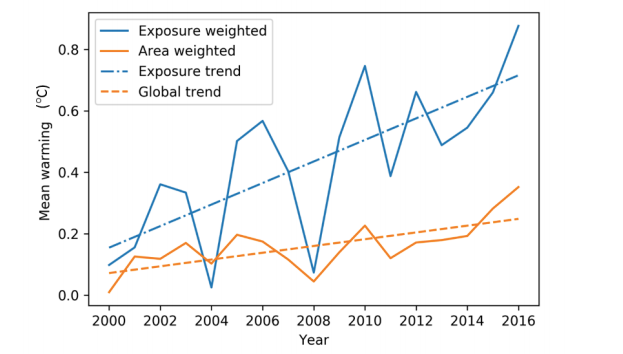In an article from the Huffington
Post, “Climate change is already taking a major toll on public health and
threatening to reverse progress made over the past century in combatting
infectious diseases, according to one of the world’s oldest and most respected
medical journals.”
In a recent news
report, the Lancet found that heatwaves have been hotter and lasted longer in
the past 2 decades. Vector-borne diseases increased as warmer temperatures
spread insects. Allergies worsened as unseasonable weather prolonged exposure
to pollen. This report was the first to chronicle the existing impacts as
opposed to the potential health effects of climate change.
“Global warming has become increasingly undeniable over the
past decade, with the past two years being the hottest successive years on
record, a title 2017 is now on track to surpass.” Heatwaves are the most
tangible effect of temperature rise. The average length of heatwaves was 0.37
days longer between 2000 and 2016. Over 125 million more people were exposed to
annual heatwaves as opposed to the period between 1986 and 2008. In 2015 alone,
175 million people were exposed to 627 heatwaves.
In the United States, the average temperature to which Americans
were exposed increased by 1.1 degrees Fahrenheit. Disease carrying insects that
thrive in warm temperatures are seeing an increase and in particular 2 species
of mosquito that carry Dengue increased their ability to spread globally by
9.4% and 11.1% since the 1950’s. Dengue is a tropical virus that causes high
fever, headache, vomiting and skin rashes. Warming temperatures helped the West
Nile virus become the most common mosquito borne disease over the past 18 years.
The number of Lyme disease cases in the U.S. has tripled over the past 2
decades as well, as warmer winters expand the area where ticks can survive.
Plant pollen is yet another outdoor menace already made
worse by climate change. Americans faced significantly longer exposure to
ragweed pollen in 2016 compared to 1990. Ragweed season lasted 17 days longer
in Bellevue, Nebraska; three weeks longer in Minneapolis, Minnesota; and
exactly 23 additional days in Kansas City, Missouri. Allergy sufferers cost the
U.S. $6.2 billion each year, and it’s not limited to hay fever. Indoor molds
and fungi also risk becoming a bigger threat.
Temperature increases alone are also causing economic
ripples. Since 2000, labor productivity around the world plummeted 5.3 percent
in rural areas, where people tend to work outside, including a dramatic 2
percent drop between 2015 and 2016. That equates to more than 920,000 people
leaving the workforce, with more than 418,000 in India alone, the report noted.
The total cost of climate-related events hit $129 billion
2016, with 99 percent of those losses in low-income countries with little or no
insurance policies. The recent wave of hurricanes that wreaked havoc in the
Atlantic ― devastating Puerto Rico, the U.S. Virgin Islands and Barbuda, as
well as mainland U.S. cities like Houston and Miami ― offered what scientists
described as examples of the kinds of storms that climate change will make more
frequent.
The report concludes that shifting to renewable energy and
dramatically reducing greenhouse gas emissions are key to preventing heat- and
climate-related maladies. On that front, the report offered some hopeful
statistics. Renewable electricity generation capacity increased by 20 percent
from 1990 to 2013, exceeding new energy capacity added by fossil fuels for the
first time in 2015. In places where renewables replaced fossil fuels ―
particularly coal, which worsens air quality and is associated with asthma and
other respiratory illnesses ― morbidity and mortality decreased.
But 1.2 billion people still lack access to electricity, and
2.7 billion rely on burning unsustainable or inefficient solid fuels, such as
coal. In the U.S., shifting to wind or solar energy from coal resulted in
between 3,000 and 12,700 avoided premature deaths from 2007 to 2015, the report
found.


No comments:
Post a Comment